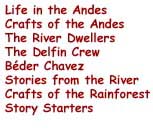

|
Thursday, November 16, 2000 Fluctuating Water Levels There are times of the year when the Río Amazonas and its tributaries are rising and the water level is high enough to flood the forest floor. In the dry season the waters recede and the rivers and lakes shrink. Yet, at other times like these the water level fluctuates from day to day depending on whether or not it has rained. Tamara and Captain Antonio have had some concern about whether we would be able to enter the mouth of the Río Samiria this morning, as the water level is so low. In the middle of the night there was a loud "slap" and the boat rocked from side to side waking everyone up—except the captain—who sleeps upstairs with us in case we need protecting. Tamara had to call to him many times before he woke up. She was afraid that the water level had fallen during the night and that the sound we heard and motion we felt was the boat settling onto the river bottom. Once awake, the captain determined that the water level had not fallen. Instead, the current had suddenly pushed the boat up against the tree to which we were anchored. We were all relieved. However, none of us slept well after that—except maybe the captain!
As we headed up the Río Samiria, white water gave way to black water and the riverbanks closed in on us. Now that we are in the Reserve there is an abundance of birds. A flock of parrots flew overhead and hundreds of cormorants were drying their wings on the shore. Ranger Station 1
Machina
Once we had our permit signed we left the station and headed up to Tipishca del Samiria, another ox bow lake to perform a zigzag transect. After the hard work of the transect, where Geoff identified his first dolphins, we had lunch and a swim in the river. We had to stay close to the boat because of the current so that we could quickly climb back in if necessary. Last year little fish nibbled our toes and legs quite a bit, but this time we were left alone. The most difficult part was getting back out of the water because the ladder was a bit precarious. The water was as warm as bath water. Of course dolphins swam very near by. Captain in Training After our swim, Shelly got to drive the boat out of the lake. Amazingly enough, the wheel was hard to turn, but when she did, the boat responded quickly. The captain kept pointing which way to go so we did not run aground. Geoff was the replacement driver and was going to dock the boat at Nueva Arica, a local village, but at the last moment the captain decided to take over. Nueva Arica We stopped at Nueva Arica to deliver the coloring books Tamara has been distributing to all the village children in the area. She and a friend created the coloring books to help educate the children about the dolphins.
Tracy took a picture of the children who surrounded the boat when we docked. She quickly loaded the picture from the digital camera to her computer, then crawled down on the bow of the boat to show the children. Instant pictures—let alone computers—are a novelty to the villagers, so the children squealed with delight when they recognized themselves and their friends. There is one teacher in the village for 70 students. He told Tamara that some of the children had found a baby dolphin that morning. The children told Tamara and Enzo that they had played with it awhile until it, "Didn't look very good any more, so we put it back in the water." Tamara always records such incidents in her log when she hears about them. As the boat pulled away, we all waved at one another. On our way out of the lake we kept a look out for the dead baby dolphin, but we didn't find it. We had planned a research excursion up the Yanayaquillo this afternoon in the skiff. This is the tributary where we saw squirrel and howler monkeys, caiman and many dolphins last year. Tonight we had planned a night excursion in the skiff to look for more caiman.
If the rain ceases we will transmit tonight. If not, there is always tomorrow. Lessons Learned Today Do your laundry even though it is raining because you never know when the sun will appear. Your clothes are just as dirty after you wash them as before—washing them just makes you feel better. Only swim by the ranger stations to avoid the 21-foot caiman. Don't flush when people are swimming along side the boat. DEET eats away nail polish. Bumps in the middle of the night usually do mean something. The mosquito nets mostly serve to trap mosquitoes IN not OUT of the net—which makes for mosquitoes bites in the most interesting places. Your Questions We are delighted to be receiving your questions and are eager to answer them. However, because of our limited power supply we are going to wait until the weekend to answer them. They will be posted to the Q&A page on Monday. |




